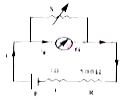A galvanometer has a resistance of 50 ohm. A resistance of 5 ohm is connected across its terminals . What part of total current will flow thorugh the galvanometer?Solution in Punjabi
Resistance of galvanometer =G=50Ω
Shunt =S=5Ω
Current flowing through galvanometer =Ig=?
Let I be the total current flowing through the circuit.
Then current flowing through shunt (S) be (I−Ig)
As the shunt resistance is connected in parallel with the galvanometer
∴(I−IG)S=IGG
IS−IGS=IGG
IS=IGS+IGG=IG(G+S)
IG=ISG+S=I(5)50+5=555I=I11IA
Topper's Solved these Questions
- BOOK - BETTER CHOICE PUBLICATIONCHAPTER - FORCE ON A CURRENTEXERCISE - LONG ANSWER TYPE QUESTIONS15videos
FORCE ON A CURRENT
- BOOK - BETTER CHOICE PUBLICATIONCHAPTER - FORCE ON A CHARGE EXERCISE - NUMERICAL PROBLEMS14videos
FORCE ON A CHARGE
- BOOK - BETTER CHOICE PUBLICATIONCHAPTER - GAUSS'S THEOREMEXERCISE - MOST EXPECTED NUMERICALS4videos
GAUSS'S THEOREM
Similar Questions
State the principle of moving coil galvanometer?
02:02View SolutionAn electron (with charge 1.6×10−19C) moving at right angles to a uniform magnetic field completes a circular orbit in 10−6sec. Calculate the vlaue of magnetic field. Given mass of electron =9×10−31kg.
04:26View SolutionA box encloses an electric dipole of 3μCand−3C, if the dipole length is 6 cm, then find total electric flux associated with box.
05:13View SolutionA galvanometer has a resistance of 50Ω. A resistance of 5Ω is connected across its terminals. What part of the total current will flow through the galvanometer?
02:57View SolutionA galvanometer of resistance 98 ohms is shunted by a resistance of 2 ohms. The fraction of the total current that pass through is.
View SolutionResistance of a galvanometer 50 Omega is. At the ends of 1 Omega Resistance is added. What fraction of the total current will flow from this galvanometer?
02:33View SolutionThe resistance of a moving coil galvanometer is 50 ohm and the maximum current which can be passed through the galvanometer is 0.002 A. What resistance (in ohm) must be connected to it order to convert in into an ammeter of range 0-0.5A?
View SolutionA galvanometer has a current sensitivity of 1mA per division. A variable shunt is connected across the galvanometer and the combination is put in series with a resistance of 500Ω and cell of internal resistance 0.5 Ω. It gives a deflection of 5 division for shunt of 5 ohm and 20 division for shunt of 25 ohm. Find the emf of cell and resistance of galvanometer.
 View Solution
View SolutionA galvanometer has a resistance of 100 ohm. A resistance of 1Ω is connected across its terminals. WHich part of the total current flows through the galvanometer? Draw the diagram.
01:27View SolutionA galvanometer of resistance, G is shunted by a resistance 5 ohm. To keep the main current in the circuit unchanged, the resistance to be put in series with the galvanometer is
01:38View SolutionA galvanometer of resistance 150 ohm is shunted such that only 1/11 of the main current flows through the galvanometer. The resistance of the shunt is, (in ohm)
02:33View SolutionThe deflection of a galvanometer falls to 20 divisions from 50 divisions when a resistance coil of 12 ohm is connected across the galvanometer coil. The resistance of the galvanometer coil in ohms is
View SolutionThe current through a Galvanometer reduces to 20% of its original value when a shunt is connected. The resistance of the galvanometer coil is 100 Ohm. Then the value of the shunt in Ohms is
View SolutionA galvanometer has a resistance of 100 Omega. A resistance of 1 Omega is connected across the terminals. What part of the total current flows through the galvanometer ? Draw the diagram.
View SolutionA galvanometer with 40 ohm resistance is connected by a 5 ohm shunt. Find the combined resistance of the shunt and the galvanometer. Find out how much current flows through this galvanometer when a 20 volt battery and an external resistance of 10 ohms are connected in series.
02:15View SolutionA galvanometer has a resistance of 50Ω. A resistances of 5Ω is connected across its terminals. What part of total current will through the galvanometer?
02:35View Solution

